Live Bird-Free: How to Install the Right Net on Your Balcony
- malik tanveer
- Aug 6
- 4 min read

Birds are a joy to watch from afar, but when they decide your balcony is their new hangout spot, the romance quickly fades. Pigeons, sparrows, and crows can leave droppings, damage plants, and even carry diseases. A balcony bird net is one of the most effective and humane ways to keep your space clean and bird‑free—without harming the animals. Here’s everything you need to know to choose the right net and bird net installation it correctly.
Understanding Why You Need a Bird Net
If you're a city dweller, you've undoubtedly observed that pigeons, in particular, love window sills and balconies. They like high, protected places to roost, rest, and occasionally even build nests. The issue? It is considerably more difficult to stop them after they have decided that your balcony is "home." Because they are acidic, bird droppings can harm metal railings, paint, and flooring. They may potentially result in structural damage over time.
In addition to causing damage to property, bird droppings can spread dangerous diseases such psittacosis, cryptococcosis, and histoplasmosis. In addition to keeping your area tidy, installing a bird net also helps you keep your family safe.
Choosing the Right Bird Net Material
Not all bird nets are created equal. The right choice depends on your location, budget, and the kind of birds you’re dealing with.
The most common material is high‑density polyethylene (HDPE) or nylon, both of which are durable and weather‑resistant. HDPE nets are balcony safety net often UV‑treated, making them ideal for outdoor use since they won’t degrade quickly in sunlight. Nylon nets are slightly softer and more flexible, but may need replacement sooner if exposed to harsh weather.
Mesh size is equally important. A smaller mesh (around 19–25 mm) is perfect for keeping out pigeons and smaller birds, while larger openings may let smaller species slip through.
Measuring Your Balcony Correctly
Before buying your net, measure your balcony space carefully. You’ll need to consider:
Height and width of the open areas – from the floor to the ceiling or railing top to balcony roof.
Depth of the balcony – especially if you have railings that need to be enclosed.
Any protrusions or architectural features – such as planters, corners, or AC units that will require adjustments installation.
Getting these measurements right is essential—too small and you’ll have gaps; too large and you’ll waste material.
Tools and Equipment for Installation
A standard balcony net installation doesn’t require advanced tools, but you will need:
The net (cut to size based on your measurements)
Sturdy hooks or anchor screws
Nylon or metal wire for securing the net edges
A hammer drill for concrete walls (if applicable)
Cable ties or strong knots for extra fastening
If you’re renting, consider using removable adhesive hooks or tension rods so you can take the net down without damaging the property.
Step-by-Step Guide to Installing a Bird Net
Step 1: Mark Your Anchor Points
Start by marking where you’ll place the hooks or screws—typically along the top edge, bottom edge, and sides of the balcony opening. The anchor points should be close enough to keep the net taut but not overly stretched.
Step 2: Install Hooks or Screws
Using a drill (for concrete) or screwdriver (for wood/metal), fix the hooks securely. If you’re using adhesive hooks, ensure the surface is clean and dry before sticking them.
Step 3: Attach the Net’s Top Edge
Unfold the net and secure its top edge to the hooks or wire. Make sure it is evenly distributed and doesn’t sag in the middle.
Step 4: Secure the Sides
Pull the net along both sides and fasten it to the hooks or wire. This step is crucial to prevent birds from squeezing through the edges.
Step 5: Fix the Bottom Edge
Attach the bottom of the net to your balcony railing or floor. If possible, run a tension wire along the bottom to keep it in place.
Step 6: Check for Gaps
Walk around and check for any small openings. Even a few inches of space can be enough for a determined pigeon. Adjust as necessary.
Maintenance and Longevity Tips
A well-installed net can last for years, but only if maintained properly. Check it periodically for holes, sagging, or broken anchor points. Clear away leaves or debris that may get caught in the mesh. If you notice fraying, repair it quickly with cable ties or a patch piece of netting to avoid a larger tear.
If your area experiences strong winds or heavy rains, inspect the net after each major weather event to ensure it’s still secure.
A Humane and Effective Solution
Instead of depending on often dangerous deterrents like spikes, ultrasonic devices, or chemical repellents, bird nets function by establishing a physical barrier. They are a low-maintenance, safe, and compassionate solution that protects both your balcony and your peace of mind.
You may enjoy your outdoor environment without unwanted winged visitors if you choose the correct material, install it securely, and maintain it over time. Installing a bird net will allow you to enjoy your morning coffee, take care of your plants, or simply unwind outside without having to worry about unexpected "gifts" from above.


Comments